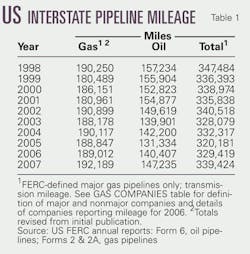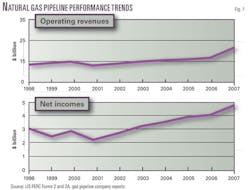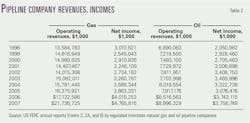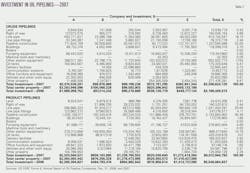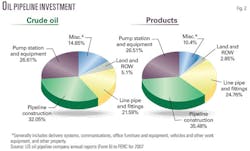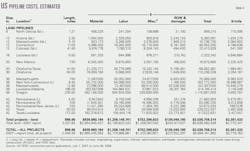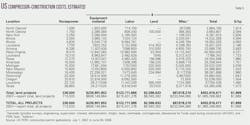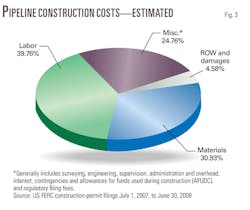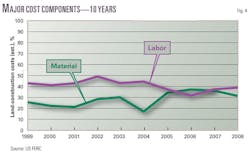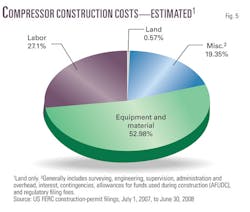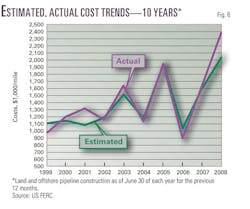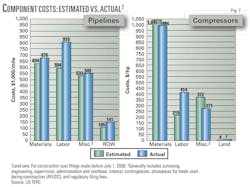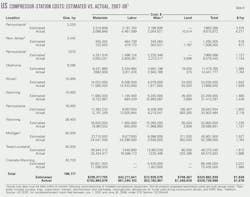Natural gas pipeline profits surge; oil flat
Natural gas pipeline operators saw their net profits surge nearly 19% in 2007 to $4.8 billion. US oil pipeline operators’ profits, meanwhile, were nearly unchanged, despite a more than 5.6% increase in operating revenues. Much of the extra revenue may have been applied to growth or acquisitions, with more than $4 billion of oil carrier property changes reported in 2007, a greater than 115% increase from the prior year.
Operators, however, began to rein in plans to expand capacity. Both the number of formal construction plans brought before the US Federal Energy Regulatory Commission for new or expanded pipeline and compression and planned expenditure fell for the 12 months ending June 30, 2008.
Proposed mileage fell by more than 50%. Compression plans followed a similar pattern, with just four of 18 projects calling for new or additional compression of 20,000 hp or greater and none calling for more than 40,000 hp.
The decreased scale of the proposed projects reflects surging costs in both material and labor. Estimated $/mile pipeline costs rose nearly 22% to more than $3.38 million/mile, while $/hp cost estimates rose 12.4%.
Pipeline labor prices maintained their premium to material and miscellaneous costs as the single most expensive per-mile item. All three categories saw increases, but labor costs rose nearly $300,000/mile.
Higher-cost labor also affected the balance between estimated and actual costs for both pipeline and compressor projects completed in the 12 months ending June 30, 2007. Actual pipeline costs exceed projected costs by nearly $373,000/mile, with labor costs making up nearly $215,000/mile of this difference.
Higher-than-anticipated labor costs also contributed almost the entire difference between estimated and actual compressor costs, with projects completed by June 30, 2008, running $40/hp more expensive than had been predicted, and actual costs for both material and miscellaneous expenses lower than estimated costs.
The difference between estimated and actual costs was even sharper for offshore projects, with actual costs running more than $4.2 million/mile higher than estimates. Companies active in the US Gulf of Mexico attributed the difference to delays and damage caused by Hurricanes Katrina and Rita in 2005.
US pipeline data
At the end of this article, two large tables (beginning on p. 65) offer a variety of data for US oil and gas pipeline companies: revenue, income, volumes transported, miles operated, and investments in physical plants. These data are gathered from annual reports filed with FERC by regulated oil and natural gas pipeline companies for the previous calendar year.
Data is also gathered from periodic filings with FERC by those regulated natural gas pipeline companies seeking FERC approval to expand capacity. OGJ keeps a record of these filings for each 12-month period ending June 30.
Combined, these data enable an analysis of the US regulated interstate pipeline system.
• Annual reports. Companies that, in FERC’s determination , are involved in the interstate movement of oil or natural gas for a fee are jurisdictional to FERC, must apply to FERC for approval of transportation rates, and therefore must file a FERC annual report: Form 2 or 2A, respectively, for major or nonmajor natural gas pipelines; Form 6 for oil (crude or product) pipelines.
The distinction between "major" and "nonmajor" appears as a note at the end of the table listing all FERC-regulated natural gas pipeline companies for 2007 at the end of this article (p. 68).
The deadline to file these reports each year is Apr. 1. For a variety of reasons, many companies miss that deadline and apply for extensions, but eventually file an annual report. That deadline and the numerous delayed filings explain why publication of this OGJ report on pipeline economics occurs in the third quarter of each year. Earlier publication would exclude many companies’ information.
• Periodic reports. When a FERC-regulated natural gas pipeline company wants to modify its system, it must apply for a "certificate of public convenience and necessity." This filing must explain in detail the planned construction, justify it, and–except in certain instances—specify what the company estimates construction will cost.
Not all applications are approved. Not all that are approved are built. But, assuming a company receives its certificate and builds its facilities, it must—again, with some exceptions—report back to FERC how its original cost estimates compared with what it actually spent.
OGJ spends the year July 1 to June 30 monitoring these filings, collecting them, and analyzing their numbers.
OGJ’s exclusive, annual Pipeline Economics Report began tracking volumes of gas transported for a fee by major interstate pipelines for 1987 (OGJ, Nov. 28, 1988, p. 33) as pipelines moved gradually after 1984 from owning the gas they moved to mostly providing transportation services.
Volumes of natural gas sold by pipelines have been steadily declining, so that, beginning with 2001 data in the 2002 report, the table only lists volumes transported for others.
The company tables also reflect asset consolidation and merger activity among companies in their efforts to improve transportation efficiencies and bottom lines.
Reporting changes
The number of companies required to file annual reports with FERC may change from year-to-year, with some companies becoming jurisdictional, others nonjurisdictional, and still others merging or being consolidated out of existence.
Such changes require that care be taken in comparing annual US petroleum and natural gas pipeline statistics.
Institution by FERC of the two-tiered (2 and 2A) classification system for natural gas pipeline companies after 1984 further complicated comparisons (OGJ, Nov. 25, 1985, p. 55).
Only major gas pipelines are required to file miles operated in a given year. The other companies may indicate miles operated, but are not specifically required to do so.
For several years after 1984, many nonmajors did not describe their systems. But filing descriptions of their systems has become standard, and most provide miles operated.
Reports for 2007 show an increase in FERC-defined major gas pipeline companies: 77 companies of 121 filing for 2007, up from 73 of 118 for 2006.
FERC made an additional change to reporting requirements for 1995 for both crude oil and petroleum products pipelines.
Exempt from requirements to prepare and file a Form 6 were those pipelines with operating revenues at or less than $350,000 for each the 3 preceding calendar years.
These companies must now file only an "Annual Cost of Service Based Analysis Schedule," which provides only total annual cost of service, actual operating revenues, and total throughput in both deliveries and barrel-miles.
In 1996 major natural gas pipeline companies were no longer required to report miles of gathering and storage systems separately from transmission. Thus, total miles operated for gas pipelines consist almost entirely of transmission mileage.
FERC-regulated major natural pipeline mileage increased in 2007, reaching its highest level since 1995 (Table 1). Final data show an increase of more than 3,000 miles, or nearly 1.7%.
Rankings, activity
Natural gas pipeline companies in 2007 saw operating revenues increase by more than $4.6 billion or nearly 27% from 2006, outstripping the gains seen in net income and leading to the lowest earnings as a percent of revenue (21.93%) since 2003.
Oil pipelines saw much the same dynamic at work, with earnings nearly flat despite the 5.63% increase in revenues.
Liquids deliveries for 2007 via pipeline rose more than 1.2 billion bbl or 9.4%, led by a more than 13% rise in products deliveries. Throughput measured in million bbl-miles (bbl-mile: 1 bbl moving 1 mile), however, fell roughly 2%, by nearly 77 billion bbl-miles, with a crude throughput drop of more than 127 billion bbl-miles, or 8.1%, more than erasing gains in product throughput.
OGJ uses the FERC annual report data to rank the top 10 pipeline companies in three categories (miles operated, trunkline traffic, and operating income) for oil pipeline companies and three categories (miles operated, gas transported for others, and net income) for natural gas pipeline companies.
Positions in these rankings shift year to year, reflecting normal fluctuations in companies’ activities and fortunes. But additionally, because these companies comprise such a large portion of their respective groups, the listings provide snapshots of overall industry trends and events.
Company financial data for all companies, not just the majors in both types of pipeline service, provide a view of the ongoing condition of these industries (Fig. 1; Table 2).
For all natural gas pipeline companies, for example, net income as a portion of operating revenues fell in 2007 to 21.93%, continuing the downward trend started in 2006. Income as a portion of operating revenues stood at 23.59% in 2005.
The percentage of income in operating revenues for oil pipelines retreated in 2007 after rebounding strongly in 2006, falling to 41.76% from nearly 44%.
Net income as a portion of gas-plant investment countered the slight decline seen in income as a portion of revenue for natural gas pipelines, moving to 4.99% after having slipped 4.55% in 2006 and eclipsing the 4.7% level last seen in 1998.
For oil pipelines, net income as a portion of investment in carrier property in 2007 eased slightly, falling to 11.45% after having risen to 11.5% in 2006. Income as part of investment in carrier property in 2004 stood at 11.4%, having risen steadily toward that level from 6.8% in 1998.
Major and nonmajor natural gas pipelines in 2007 reported an industry gas-plant investment of more than $95.5 billion, the highest level ever, up from nearly $88.3 billion in 2006, $84 billion in 2005, more than $83 billion in 2004, nearly $78 billion in 2003, $74.2 billion in 2002, almost $71 billion in 2001, $68 billion in 2000, and nearly $66 billion in 1999.
Investment in oil pipeline carrier property also continued to rise in 2007, reaching almost $35.9 billion after rebounding to $32.7 billion in 2006 from the lowest level seen since at least 1997, 2005’s $29.5 billion.
OGJ for several years has tracked carrier-property investment by five crude oil pipeline and five products pipeline companies chosen as representative in terms of physical systems and expenditures (Table 3). In 2003, we added the base carrier-property investment to allow for comparisons among the anonymous companies.
The five crude oil pipeline companies in 2007 increased their overall investment in carrier property by more than $40.2 million, or nearly 1.3%; the same grouping of companies increased overall investment in carrier property in 2006 by more than $38.4 million, or 1.2%. The increases of the group overall have come despite one of the five having lowered its investment in carrier property for the past 3 years.
The five products pipeline companies increased overall investment in carrier property in 2007 by $463 million, or 8.35%, following a more modest 2006 increase of $182 million, or 3.39%. These increases came despite a roughly $140 million reduction in investment by one of the five.
Comparisons of data in Table 2 with previous years must be done with caution: in 2004, a major crude oil pipeline company listed their sold significant assets, making comparisons with previous years’ data difficult.
Investment by the five product pipeline companies in 2007 was more than $6 million, continuing a return to growth started in 2003 when investment of more than $4.7 billion was up from 2002’s $4.5 billion level.
Fig. 2 illustrates the investment split in the crude oil and products pipeline companies.
Construction wavers
Applications to FERC by regulated interstate natural gas pipeline companies to modify certain systems must, except in certain instances, provide estimated costs of these modifications in varying degrees of details.
Tracking the mileage and compression horsepower applied for, and the estimated costs can indicate levels of construction activity over 2-4 years. OGJ has been doing that since this report began more than 50 years ago.
Tables 4 and 5 show companies’ estimates during the period July 1, 2007, to June 30, 2008, for what it will cost to construct a pipeline or install new or additional compression.
These tables cover a variety of locations, pipeline sizes, and compressor-horsepower ratings.
Not all projects that are proposed are approved. And not all projects that are approved are eventually built.
Applications filed in the 12 months ending June 30, 2008, fell sharply following 3 years of sustained strength:
• Roughly 900 miles of pipeline were proposed for land construction, and no new offshore work. The land level is down from the nearly 2,050 miles proposed in 2007, the 1,450 miles proposed in 2006, and the 1,700 miles proposed in 2005.
• New or additional compression proposed by the end of June 2008 measured 238,500 hp, down substantially from the 713,000 hp reached in 2007 and 583,000 hp seen in 2006, but still more than the 175,000 hp envisioned by the pipelines in 2005 (Table 5).
Putting the downturn in US gas pipeline construction in even starker perspective, Table 4 lists 19 land-pipeline "spreads," or mileage segments, and no marine projects, compared with:
• 25 land and 1 marine project (OGJ, Sept. 3, 2007, p. 51)
• 42 land and 1 marine project (OGJ, Sept. 11, 2006, p. 46).
• 56 land and 4 marine projects (OGJ, Sept. 12, 2005, p. 50).
• 15 land and 0 marine projects (OGJ, Aug. 23, 2004, p. 60).
• 37 land and 3 marine projects (OGJ, Sept. 8, 2003, p. 60).
• 83 land and 3 marine projects (OGJ, Sept. 16, 2002, p. 52).
• 49 land and 2 marine projects (OGJ, Sept. 3, 2001, p. 66).
• 115 land and 6 marine projects (OGJ, Sept. 4, 2000, p. 68).
Further, of the 19 projects applied for, only 8 are for pipelines of 50 miles or more in length, with just three of these being for projects over 100 miles long (and 2 of the 8 of 42-in. OD).
For the 12 months ending June 30, 2008, the 19 land projects would cost just more than $3 billion as compared with the $5.6 billion planned for 25 projects a year earlier. The smaller number and scale of these filings indicates a potential pause in addressing the infrastructural needs associated with US natural gas demand growth.
Projects’ cost projections indicate much about where companies believe unit construction costs ($/mile) are headed. It is telling that even with the scale diminished, estimated $/mile costs for the new projects continued to rise.
For proposed US gas pipeline projects in 2007-08, the average land cost was $3.381 million/mile; in 2006-07, the average land cost was $2.775 million/mile; for 2005-06, the average land cost was $1.95 million/mile; for 2004-05 the average land cost was $2.2 million/mile; and for 2003-04 the average land cost was $1.7 million/mile.
Cost components
Variations over time in the four major categories of pipeline construction costs—material, labor, miscellaneous, and right-of-way (ROW)—can also suggest trends within each group.
Materials can include line pipe, pipe coating, and cathodic protection.
"Miscellaneous" costs generally cover surveying, engineering, supervision, contingencies, telecommunications equipment, freight, taxes, allowances for funds used during construction (AFUDC), administration and overheads, and regulatory filing fees.
ROW costs include obtaining rights-of-way and allowing for damages.
For the 19 land spreads filed for in 2007-08, costs-per-mile projections for the four categories all showed increases, with miscellaneous charges showing a particularly sharp jump:
• Material—$1,045,846/mile, up from $1,011,471/mile for 2006-07.
• Labor—$1,344,389/mile, up from $1,052,658 for 2006-07.
• Miscellaneous—$837,246/mile, up from $595,552/mile for 2006-07.
• ROW and damages—$154,729/mile, up from $115,659/mile for 2006-07.
Table 4 lists proposed pipeline in order of increasing size (OD) and increasing lengths within each size.
The average cost-per-mile for the projects rarely shows clear-cut trends related to either length or geographic area. In general, however, the cost-per-mile within a given diameter indicates that the longer the pipeline, the lower the unit (per-mile) cost for construction. And lines built nearer populated areas tend to have higher unit costs.
Additionally, road, highway, river, or channel crossings and marshy or rocky terrain each strongly affects pipeline construction costs.
Fig. 3, derived from Table 4, shows the major cost-component splits for pipeline construction costs.
Despite increases in other categories, labor remained the single largest portion of land construction costs. Labor’s portion of estimated costs for land pipelines moved to 39.76% in 2008, from 37.93% in 2007 and 32.35% in 2006. Material costs for land pipelines continued to rise in absolute terms even while slipping as a percentage of total costs in 2008 to 30.93% from 36.44% in 2007 and 38.17% in 2006.
Fig. 4 shows a 10-year comparison of land-construction unit costs for the two major components: material and labor.
Fig. 5 shows the cost split for land compressor stations based on data in Table 5.
Table 6 lists 10 years of unit land-construction costs for natural gas pipelines with diameters of 8-36 in. The table’s data consist of estimated costs filed under CP dockets with FERC, the same data shown in Tables 4 and 5.
Table 6 shows that the average cost per mile for any given diameter may fluctuate year to year as projects’ costs are affected by geographic location, terrain, population density, or other factors.
Completed projects’ costs
In most instances, a natural gas pipeline company must file with FERC what it has actually spent on an approved and built project. This filing must occur within 6 months after the pipeline’s successful hydrostatic testing or the compressor’s being put in service.
Fig. 6 shows 10 years of estimated vs. actual costs on cost-per-mile bases for project totals.
Tables 7 and 8 show such actual costs for pipeline and compressor projects reported to FERC during the 12 months ending June 30, 2008. Fig. 7, for the same period, depicts how total actual costs ($/mile) for each category compare with estimated costs.
Per-mile pipeline construction costs for completed projects rose by nearly 51%, after jumping more than 86% a year earlier. After leading the price surge last year, labor posted the smallest per-mile increase of the cost categories for completed projects in the 12 months ending June 30, 2008.
Even so, actual costs were 18.6% higher than projected costs for the 12 months ending June 30, 2008, with the price of labor running 40.4% higher than had been anticipated. Some of these projects may have been proposed and even approved much earlier than the 1-year survey period. Other may have been filed for, approved, and built during the survey period.
If a project was reported in construction spreads in its initial filing, that’s how projects are broken out in Table 4. Completed projects’ cost data, however, are usually reported to FERC for an entire filing, usually but not always separating pipeline from compressor-station (or metering site) costs and lumping several diameters together.
The 12 months ending June 30 saw more than 196,000 hp of new or additional compression completed, reversing recent declines that saw more than 96,000 hp completed in 2007, 106,000 hp completed in 2006, and 153,000 hp of new or additional compression completed in 2005 vs. 468,000 hp in 2004.
More than half of the 2007-08 horsepower came from three projects.
Actual compression costs ran within $40/hp of estimates, with declines in material costs and miscellaneous expenses countering higher than expected prices of labor (Table 8).

Christopher E. Smith | Editor in Chief
Christopher brings 27 years of experience in a variety of oil and gas industry analysis and reporting roles to his work as Editor-in-Chief, specializing for the last 15 of them in midstream and transportation sectors.


